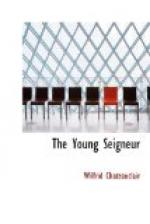It was also the centre by position; being situate about mid-way between the ends of the long street, standing back commanding the only square, which was flanked on its two sides by the sole other edifices of public character, the priest’s residence, or presbytere, and the friars’ school for boys.
It is needless to say that the Church was the central fact architecturally also. Large and of ancient look, its wrinkled, whited, rude-surfaced face was impressive, notwithstanding that it was relieved by but little ornament; for its design was from the hand of some by-gone architect of broad and quiet ability.
Be in no hurry, friend reader, but let us look it over, for it is an antiquity, and worthy of the title.
The facade consisted of a great gable, flanked by two square towers. The gable roof had a steep mediaeval pitch, and was pinnacled by the statue of a saint. A small circular window was set in the angle, and looked like the building’s eye. Three larger windows and the great door came below in the broad front at their proper stages of the design; and in the centre a cut stone oval, bore the date “1761,” in quaint figures—a date that seemed a monument of the fatal storming of Quebec, just over, and the final surrender of Montreal, just to be made—the end of French dominion over three quarters of North America!
A number of details afforded entertainment to the curious eye. There were the rude capitals “St. J.B.” and “St. F.X.” on the keystone of the round-arched side doors at the foot of the towers. There were the series of circular windows leading one above another, on the towers, up to the charming belfry spire which crowned them. There were high up in the air on the latter, the fleur-de-lys and cock weather-vane, symbolical of France. Nine gables too, had the church, of various sizes. Its roof was shingled and black, and where it sloped down in the rear, a little third belfry pointed its spire. A stout, stone sacristy grew out behind. A low pebbled platform, two steps high, extended in front, and had a crier’s pulpit upon it. And amid these varied features, the body of the church on all sides cloaked itself in its black roof with a mien of dignity, and its graceful tin-covered belfries, fair in their mediaeval patterns and pointing sweetly to heaven, glinted far over the leagues of the River.
Yet it was not alone as to prominence of appearance, situation, and architectural attractiveness—that Dormilliere found its centre in the Parish Church. No relation of life, no thought, no interest, no age in years, but had its most intimate relation with it. There alike weary souls crept to pray for consolation, and vain minds sought the pomp of its ecclesiastic spectacles and ceremonies; the bailiff cried his law-sales before it, the bellman his advertisements; there was holy water for the babe, holy oil for the dying, masses for the departed; the maiden and the laborer unveiled their secret lives in its confessional-box; and all felt the influence, yea some at that period, the sternly asserted rule, of the Master of the institution.




